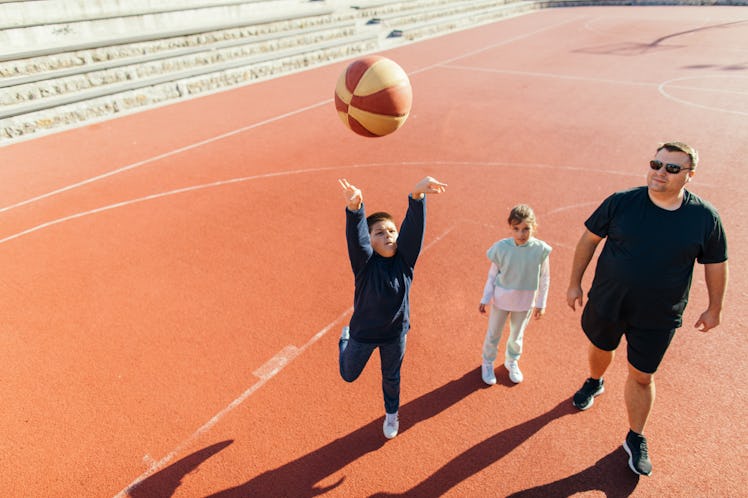How To Teach Your Kid To Shoot A Basketball
Just because they can't pick up a regulation ball doesn't mean they can't hit that swish.

Michael Jordan. LeBron James. Steph Curry. No matter the era, the NBA has always had a superstar that inspires children to pick up the ball and go shoot some hoops in the driveway — or the living room. While a hoops-loving toddler might already be trying James Hardenesque step-back 3s in his brain, it’s more likely that parents will want to teach their superstars-in-the-making all about the fundamentals. After all, basketball is the most popular sport for kids in the United States, and learning the basics could help kids stand out in a crowded (and fun) field.
Just like kicking a soccer properly doesn’t boil down to “run up and hit it with your foot,” learning to shoot a basketball is a process that goes beyond “throw the ball at the hoop.” Proper form, wrist control, and practice on appropriately sized hoops all help teach kids to put it up. That may mean starting off a toddler with a mini-basketball and a plastic hoop, but it also means having a plan to size up.
To that end, we talked to Wilky Colin, president and coach at Breakaway Hoops in Manhattan, New York, about the proper way to teach kids how to shoot. Breakaway has programs for kids as young as 5 years old so Colin has experience working with kids early on in the learning process. His advice? Focus on balance. With good balance – and a handful of additional tips – kids can go from seeing Kevin Durant on TV to properly imitating the big man’s beautiful stroke.
Get Balanced
Before your kid even touches a basketball, they should practice their stance. Colin believes that balance in your legs is the most important part of learning to shoot: “Everything starts with the base and balance. The base are your feet, and the balance comes from your legs.” What does that mean practically? He says that the feet should always be straight and pointed to the rim, and shoulder-length apart. Once you teach that, then you can move on to the shooting, but making sure there’s a strong foundation will set your child on the right path.
Identify The Shooting Hand
Of course, a child can’t shoot if he doesn’t know what hand to shoot with. While it seems simple – is your kid a righty or a lefty? – identifying which hand they are more comfortable shooting with is an important step that could save a lot of problems later on. “The shooting hand is the more dominant hand, while the guide hand helps,” says Colin. “Once we have the balance, you have to identify the stronger hand before doing anything else.” Believe it or not, this is a problem all through a player’s development; just take a look at Sixers rookie Ben Simmons, who someone believe might be shooting with his guide hand while in the NBA. Getting a definitive answer to this question early on will help development.
Mini-Hoops First, Free Throws Later
Finally, it will be time to shoot! Well, there’s one more thing to knock out: what kind of ball and hoop should you use? Colin’s thoughts generally align with what you would expect.
“For a small kid, say 4, 5, 6, 7 years old, you need to figure out a smaller ball and hoop. For the ball, you generally want a junior basketball, called Size 4 or 25.5. That’s a lighter ball, easier for younger kids, which will give them the confidence to shoot the ball,” Colin explains. “As for the hoop, that’s a lot more varied. For smaller kids, a 6-foot rim works. Maybe an 8-foot if they’re older or bigger for their age. You don’t want to move them to a 10-foot rim for a few years.”
10-foot rims, of course, are the standard, but a 6 year old is only going to get frustrated heaving a too-heavy ball that high.
Follow-Through Is Key
Without further ado, the actual act of shooting: it’s all about the body going in one motion. You want to catch the ball in a “shot pocket position,” according to Colin: “Feet shoulder-length apart, facing the basket, knees bent, and arms out and slightly bent, ready to catch the ball.” Once the ball is in your kid’s hands, they should bend the knees, push the arms forward, and let it fly.
Keeping the arm at a 90-degree angle will make sure that it flies at the right height, but Colin’s other key tip is one that might be ignored normally: the follow-through. “The most important part is to follow-through towards the rim, every time. If your kid is able to follow through in the direction of the rim, their shots will be straighter and more likely to go in.”
Don’t Copy the Pros!
Colin’s final piece of advice is likely the hardest to implement, especially as the NBA becomes more and more popular: Don’t copy the pros! “Most kids want to come into the gym and shoot 3-pointers, but that’s not how you should start,” he says with a laugh. “You have Curry, Harden, Klay Thompson. All of them are inspiring kids to chuck threes, but they don’t understand that they need the mechanics first.” Without the fundamentals, your kid might look cool shooting from deep with his friends…until his shots go completely awry. By showing them the basics, you can encourage them to repeat and master them so that they can become sharpshooters in the future.